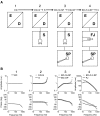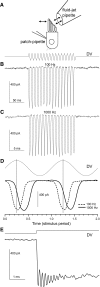Frequency-dependent properties of a fluid jet stimulus: calibration, modeling, and application to cochlear hair cell bundles
- PMID: 17387553
- PMCID: PMC1915593
- DOI: 10.1007/s10162-007-0080-0
Frequency-dependent properties of a fluid jet stimulus: calibration, modeling, and application to cochlear hair cell bundles
Abstract
The investigation of small physiological mechano-sensory systems, such as hair cells or their accessory structures in the inner ear or lateral line organ, requires mechanical stimulus equipment that allows spatial manipulation with micrometer precision and stimulation with amplitudes down to the nanometer scale. Here, we describe the calibration of a microfluid jet produced by a device that was designed to excite individual cochlear hair cell bundles or cupulae of the fish superficial lateral line system. The calibration involves a precise definition of the linearity and time- and frequency-dependent characteristics of the fluid jet as produced by a pressurized fluid-filled container combined with a glass pipette having a microscopically sized tip acting as an orifice. A procedure is described that can be applied during experiments to obtain a fluid jet's frequency response, which may vary with each individual glass pipette. At small orifice diameters (<15 mum), the fluid velocity of the jet is proportional to the displacement of the piezoelectric actuator pressurizing the container's volume and is suitable to stimulate the hair bundles of sensory hair cells. With increasing diameter, the fluid jet velocity becomes proportional to the actuator's velocity. The experimentally observed characteristics can be described adequately by a dynamical model of damped fluid masses coupled by elastic components.
Figures








Similar articles
-
The design, calibration, and use of a water microjet for stimulating hair cell sensory hair bundles.J Acoust Soc Am. 1989 Nov;86(5):1797-804. doi: 10.1121/1.398612. J Acoust Soc Am. 1989. PMID: 2808929
-
Hydrodynamic detection by cupulae in a lateral line canal: functional relations between physics and physiology.Biol Cybern. 2006 Jan;94(1):67-85. doi: 10.1007/s00422-005-0032-x. Epub 2005 Nov 29. Biol Cybern. 2006. PMID: 16315048
-
Mammalian auditory hair cell regeneration/repair and protection: a review and future directions.Ear Nose Throat J. 1998 Apr;77(4):276, 280, 282-5. Ear Nose Throat J. 1998. PMID: 9581394 Review.
-
Mechanoelectrical transduction assisted by Brownian motion: a role for noise in the auditory system.Nat Neurosci. 1998 Sep;1(5):384-8. doi: 10.1038/1597. Nat Neurosci. 1998. PMID: 10196528
-
Two types of cochlear hair cells with two different modes of activation are better than one.J Basic Clin Physiol Pharmacol. 2012 Jan 11;23(1):1-3. doi: 10.1515/jbcpp-2011-0036. J Basic Clin Physiol Pharmacol. 2012. PMID: 22865443 Review.
Cited by
-
The physiology of mechanoelectrical transduction channels in hearing.Physiol Rev. 2014 Jul;94(3):951-86. doi: 10.1152/physrev.00038.2013. Physiol Rev. 2014. PMID: 24987009 Free PMC article. Review.
-
Mechanotransduction in mammalian sensory hair cells.Mol Cell Neurosci. 2022 May;120:103706. doi: 10.1016/j.mcn.2022.103706. Epub 2022 Feb 23. Mol Cell Neurosci. 2022. PMID: 35218890 Free PMC article. Review.
-
The role of transmembrane channel-like proteins in the operation of hair cell mechanotransducer channels.J Gen Physiol. 2013 Nov;142(5):493-505. doi: 10.1085/jgp.201311068. Epub 2013 Oct 14. J Gen Physiol. 2013. PMID: 24127526 Free PMC article.
-
Fluid Jet Stimulation of Auditory Hair Bundles Reveal Spatial Non-uniformities and Two Viscoelastic-Like Mechanisms.Front Cell Dev Biol. 2021 Aug 26;9:725101. doi: 10.3389/fcell.2021.725101. eCollection 2021. Front Cell Dev Biol. 2021. PMID: 34513845 Free PMC article.
-
Hair Bundle Stimulation Mode Modifies Manifestations of Mechanotransduction Adaptation.J Neurosci. 2019 Nov 13;39(46):9098-9106. doi: 10.1523/JNEUROSCI.1408-19.2019. Epub 2019 Oct 2. J Neurosci. 2019. PMID: 31578232 Free PMC article.
References
Publication types
MeSH terms
Substances
LinkOut - more resources
Full Text Sources

